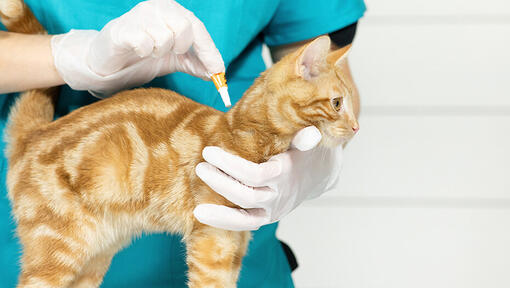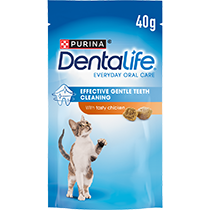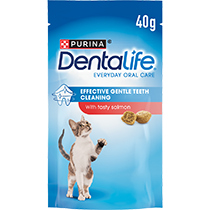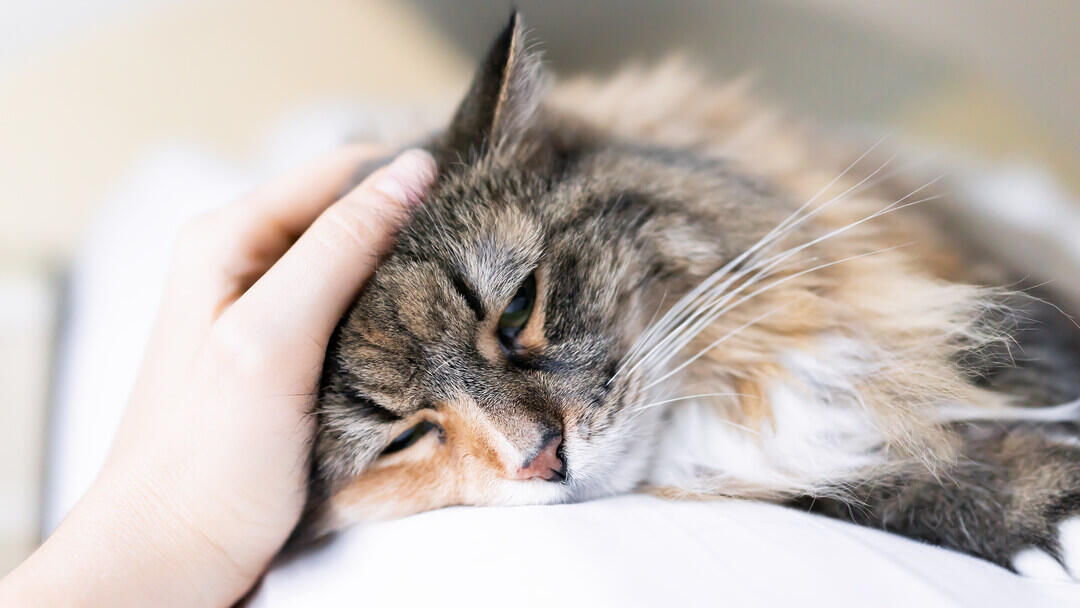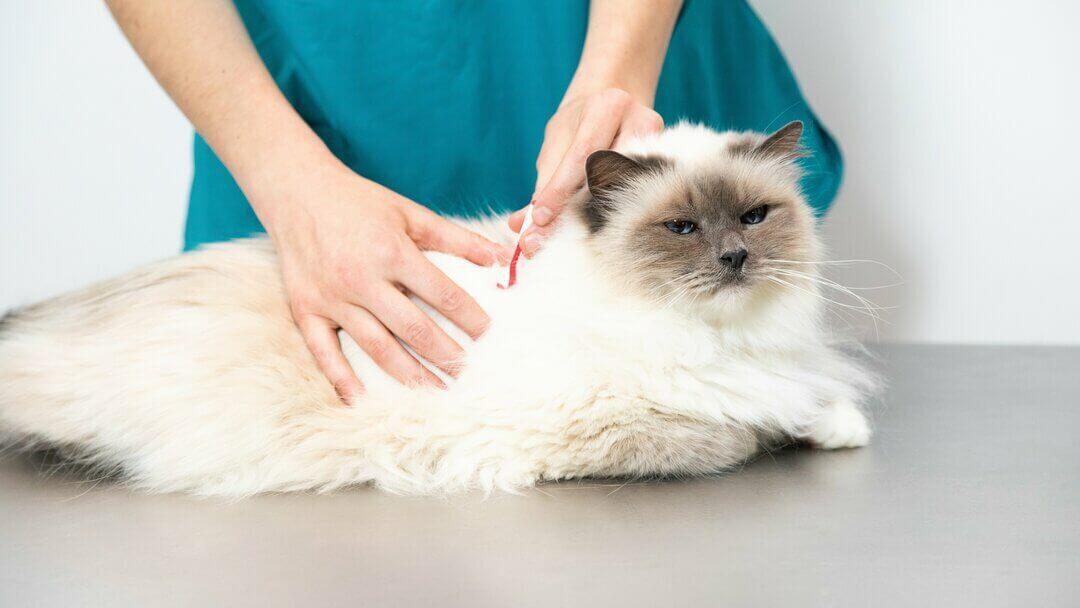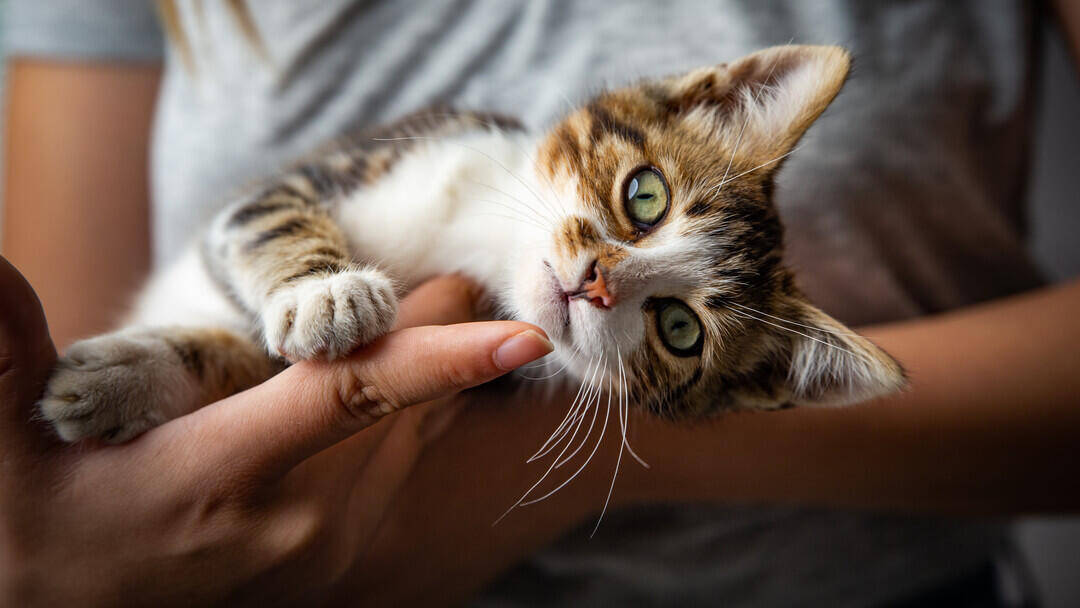
Cat fleas are very normal and they’re the most common reason for a cat to develop a skin problem.
What are cat fleas?
The most common type of flea found on cats is the cat flea (Ctenocephalides felis), but rabbit and hedgehog fleas can also show an interest in your cat! Flea bites are itchy for all cats, and can lead to some developing allergies (known as flea-allergic dermatitis). As if fleas weren’t pesky enough, they can also provide a thriving environment for certain types of tape worm, and heavy infestations can cause anaemia in kittens.
However, there’s no need to worry, as there are a number of different cat flea prevention options for you to look at.
Cats are excellent groomers, so it might be tough to imagine your preened pet catching parasites! The most obvious sign that your cat has fleas is persistent scratching, or sometimes over-grooming, which can result in bald patches on their coat. If your cat develops a flea allergy, they may also have scabs and red, sore areas on their skin. Regularly grooming your cat won’t necessarily prevent parasites, but at least you’ll have a chance to check their fur for any signs of unwanted visitors, so that you can quickly seek treatment.
What do cat fleas look like?
Cat fleas are dark brown and 1-2mm long. You might spot them in your carpet or notice tiny black specks of flea waste in your cat’s fur during combing. A good way to test for fleas is to put these black specks onto some damp tissue paper – if it is from a flea, the specks will turn red because of the digested blood they contain.
Fleas thrive in warm, humid environments, which means late summer is the peak season for fleas on cats, however central heating in the winter means that flea prevention is a must all you round.
Does your cat have fleas?
Finding it hard to tell whether or not your cat has caught this tiny parasite? Here are the most common signs of cat fleas to watch out for:
- Non-stop scratching
- Spots showing hair loss
- Skin irritation
- Excessive grooming
- Lethargy and pale gums caused by flea-related anaemia
- Black speck in the cat’s fur or bedding
How do cats get fleas?
Roaming outdoors all day long seems like the sure recipe for bringing home a family of fleas. But even if your feline is a homebody, parasites such as fleas might have plenty of occasions to land into the luscious fur of your indoor cat. Here is how cats can catch fleas:
Even a quick trip to the vet is enough time to allow a pesky flea to find its way to your indoor pet. Places like the vet’s office or catteries are visited by many other fellow cats. If one of them already has fleas, there are chances that some will be left behind, waiting for another pet to show up.
If your cat is sharing their space with other animals, consider that maybe other pets have brought in these tiny insects and your cat was their next perfect target.
Cats love their little mouse-hunting missions. But if one of their victims is the host of a few pairs of fleas, they can easily jump ship and infect your cat instead.
Oftentimes moving into a new house doesn’t mean the place is totally empty and that fleas have moved out too. If you’ve recently moved in with your cat, take into consideration thoroughly cleaning the place once again, or even contact experts in flea control for a professional service if you think it’s necessary.
How to get rid of fleas on cats?
If you think your cat has fleas, speak to your vet for information on suitable cat flea treatments – and make sure you check with them before using any over-the-counter product.
Never use a dog flea product on your cat as the active ingredient, permethrin, can be extremely toxic to your cat. If you have dogs as well as cats, don’t treat your dogs with any flea treatment products containing this chemical as cats can be exposed to it by contact. If your cat has a bad reaction to a cat flea product you should tell the Veterinary Medicines Directorate. More information is available from International Cat Care.
When you’re deciding how to get rid of fleas on cats, remember you’ll have to treat your house as well as your cat. You should use a combination of topical products to kill the adult fleas, plus a house treatment that will prevent eggs developing into adults. Make sure all soft furnishings and carpets are regularly thoroughly washed on a high heat, too. All these flea prevention steps are key to keeping a flea free home.
Remember, it’s very important you speak to your vet before treating your cat, particularly if they’re pregnant or feeding new kittens. Some off-the-shelf products are less effective than prescribed products, and cats can even build up an immunity to these treatments. Your vet will be able to advise on the best cat flea treatment for your cat.
Top 6 topical cat flea treatments
There are a wide variety of cat flea treatments available that can be applied directly to onto your cat’s skin and fur to target the fleas where they live on your pet.
Sprays are also used less frequently than they used to be, thanks mainly to the invention of the ‘spot-on’ treatments. The noise of the spray can also upset nervous cats. However, a pump action spray containing an ingredient called fipronil can be used on very young kittens, which aren’t allowed to use spot-on treatments.
Flea collars aren’t usually very effective as they have a limited range – that is, they only treat the area around the neck – and can also cause hair loss or irritation. However, there is a new generation of cat flea collars – available from your vet – which are much kinder to your cat’s skin and fur, and work by dispersing the active ingredient through the body rather than simply sitting on your cat’s neck. Remember, all cat flea collars must have a quick-release mechanism, otherwise your cat can get easily tangled.
These products are the simplest form of cat flea prevention. They usually consist of a small vial of liquid which should be applied to the back of your cat’s neck, killing fleas and sometimes the development of eggs. There are several brands available, so talk to your vet to find the best one for your cat.
As well as topical treatments, you can treat you cat from the inside with medicines. This type of cat flea treatment is something you should consult your vet about.
Cat fleas can also be treated orally through tablets and liquids which are absorbed by the cat and then kill or sterilise fleas when they bite. This is something your vet can offer more information about.
Cats can have an injection in order to prevent flea eggs, but you’ll usually have to use a topical treatment at the same time to totally get rid of the existing cat fleas. Ask your vet about this to find out more.
How to get rid of cat fleas in your home
Some of the cat flea prevention methods mentioned above are helpful in treating your house as well, as they prevent fleas from laying eggs, or prevent the eggs from developing. However, there are many household sprays available that can be used on carpets and furnishings.
Always follow the manufacturer’s instructions, which will usually tell you to vacuum your carpets to bring cat fleas and eggs to the surface before thoroughly spraying your carpet, and then vacuuming again. Always spray the vacuum cleaner with flea spray and throw away any vacuum bags so that fleas can’t continue to develop inside.
Don’t use sprays near fish tanks and always make sure your pets are kept away from treated areas until they’ve been well-ventilated. Unfortunately, very severe infestations in a house may require pest control treatment.
It’s also a good idea to thoroughly wash the bedding and fabrics your cat comes into contact with. Use hot water and a detergent as both the heat and soap can help kill fleas and eliminate their eggs.
Controlling the flea population outdoors is more challenging, especially as contact with other cats is the main cause of transmission. If you have a garden and your cat loves to spend time outdoors, you can use flea control products specifically designed for outdoor use, focusing on any areas where you know other cats spend time.
Other treatments for cat fleas
Wondering how to get rid of fleas on cats naturally? Some cat flea treatments based on oil of citronella or eucalyptus exist, but these aren’t recommended for cats. Cats are especially sensitive to toxicity from a wide range of essential oils, including citronella and eucalyptus oils, while the strong scent of citronella oil means it’s sometimes even used as a cat repellent. These products often haven’t undergone any stringent safety or efficacy tests, so they may not be effective and could affect your cat’s health. It’s best to speak to your vet before using any of these products.
If you think your cat might have ticks, check out our easy-to-follow guide on how to remove a tick from a cat.



